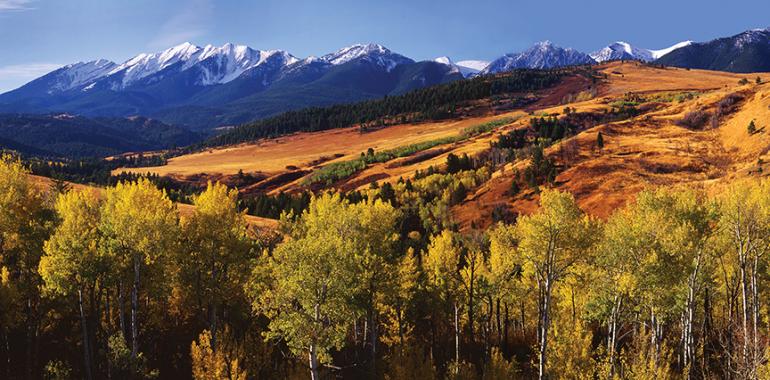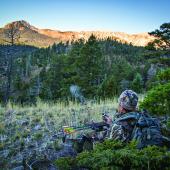Mountain High
The late writer John Madson once wrote a sweet, short essay titled “The High Beyond” that encapsulates it all:
“This mountain country expands and intensifies many things that men love and dread in the outdoors. It’s a land of heroic exaggeration where you can breathe more and get less air, walk farther and make less distance, take a quicker bath, have more sudden weather, and spit farther than anywhere else in North America.”
For those of us who enjoy Montana, there’s nothing like autumn in the mountains. Up there, beyond our valleys and foothills, lies a mystery. A mountain lake in a hidden drainage, a bull elk wallowing and splashing in mid-rut lust, a lichen-crusted granite slab tilted toward the coming day. Down here, we have our cars and our avenues, up there are pines and pathways.
Mountains in Montana are by and large public land. With a few notable exceptions—Big Sky being one—most of the higher country in this state is owned by everyone and is open to anyone with a good set of legs and lungs. This is where we go to hunt the game that will fill our freezers. This is where we get the meat for our summer barbecues and winter potlucks. The mountains are our playground, but also our grocery. And no matter if your quarry is deer, elk, goat, or grouse, this is a place that demands preparation.
If you’ve got your eye on a mountain, it’s better to know before you go—it’s called research. Talk to people before you go, spend some time online, look at maps.
I have a good buddy who found a fantastic blue-grouse hunting spot by getting on Google Earth and identifying likely habitat from outer space. When he hiked up to the spot with his Griffon pup, he found a load of grouse for the gun. The computer took him there virtually, but reality called for worn boot leather and sweat.
There are also several good hunting programs like OnXmaps that have fantastic maps and other information that you can download to your cell phone before you go. For those of us who are old-school, there’s no substitute for the old topographical and U.S. Forest Service maps. A GPS is a particularly nice touch, especially in thick timber that is generally featureless. No matter your mode of exploration, the research will take care of a lot of misadventure and misdirection.

Pinning down the spot to go hunting is one thing. But the most important thing, more than anything else, is telling someone where you are going and when you will be back. Hundreds of hours of search-and-rescue efforts have been wasted by people looking for someone who didn’t come back just because no itinerary was left behind as a safety valve. The best adventurers have a map and a plan and do not stray from it.
While a plan is well and good, things go wrong, and being able to right them is on you in the high country. Learn to navigate game trails to highpoints along ridgelines. From an elevated vantage point, look for landmarks such as rivers or well-known peaks. Again, map study could be key in getting found when you’re lost. Game trails and ridgelines also help conserve energy, so use them even when you aren’t lost.
Once all of that is lined out, you are ready to go. Even if you’re only going for a short day, you should go prepared. Into a daypack you’ll tuck everything you need for your adventure, and then some. No matter the month, you’ll need to take extra clothing layers, particularly rain layers and a dry insulating layer. No cotton. Fleece and other synthetics are the idea. If you’re going into bear country—and most of southwestern Montana is—you’ll want to pack bear spray.
You’ll need to pack those maps, whether they exist on your phone or on paper. A good knife, some matches or a lighter, fire-starter, a small first-aid kit. High-energy snacks are important too. A warm hat. Imagine having to spend a night out unexpectedly. What would you need? If you start thinking that way, and keeping it light at the same time—a small space blanket is a heck of a lot easier to cart around than a sleeping bag—you will get the idea. You want to think comfort. You want to enjoy your hunt in the mountains by having a pack that doesn’t kill you because it’s too heavy, but you’ll also want to carry just enough gear so if something happened, you could spend a night out if need be. I once spent a night out in the rain huddled up under a giant spruce tree because I shot a mountain sheep late in the afternoon and daylight disappeared before I could get off a rough piece of country back to my camp. It rained during the night, then changed to snow, and yet I survived because I had just the right amount of gear. Not too much, not too little. I wasn’t particularly comfortable, but it was a lot safer staying the night out than trying to stumble to camp in pitch-black deadfall timber.

As you go into the mountains, don’t rush it. Use those binoculars you packed along to find the best travel routes. Stop and look at the map from time to time. Stay hydrated. Move on. For the average hunter, this is just common sense, but sometimes when you are hot on the track of game, you forget to slow down, to listen and move carefully. Travel and move thoughtfully. If you are going alone, go carefully. If you are with someone, remember that you are partly responsible for them and their safety too.
But more than anything, enjoy it. These are your mountains as much as the next person’s and hunting is your heritage that is uniquely American.
Tom Reed writes from his house outside Pony where he and his family maintain a pack of bird dogs between hunting seasons. A new version of his book, Give Me Mountains For My Horses, was released this past summer by Skyhorse Publishing and can be found in local bookstores.
This article originally appeared in Stalk hunting guide, an annual guide to hunting southwest Montana.











